current location:Home>>2018 Festival>>Archives>>The 7th Beijing International Film Festival>>International Digital Cinema Technology Forum
International Digital Cinema Technology Forum
International Digital Cinema Technology Forum Held——Chinese and foreign filmmakers focus on how technologies change films
The International Digital Cinema Technology Forum, hosted by the Organizing Committee of the Beijing International Film Festival (BJIFF) and organized by the China Research Institute of Film Science & Technology (CRIFST), was held at Beijing International Hotel on April 19. This is a theme forum of BJIFF starting this year to implement the national strategy of technology innovation and development, constantly improve China's film technologies, and accelerate the building of China into a film power, as well as the first such theme forum organized by CRIFST. The State Administration of Press, Publication, Radio, Film and Television (SAPPRFT) of the People's Republic of China, the CPC Beijing Municipal Committee and the People's Government of Beijing Municipality have attached great importance to the forum. Wang Ning, Vice Mayor of the People's Government of Beijing Municipality and Executive Vice Chairman of the Organizing Committee of BJIFF; and Zhang Pimin, Vice President of the China Alliance of Radio, Film and Television attended and addressed the forum. They spoke highly of the forum and extended warm congratulations on the opening of the forum. Other attendees include Li Guoqi, Vice Minister of SAPPRFT; Sun Suchuan, Deputy Director-General of the Science & Technology Department, SAPPRFT; Yang Shuo, Secretary of the Party Leadership Group and Director-General of the Beijing Municipal Bureau of Press, Publication, Radio, Film and Television (BJBPPRFT); Hu Dong, Deputy Director-General of BJBPPRFT; Bian Jianguo, Associate Counsel of BJBPPRFT; Wang Jue, Editor-in-Chief of Beijing Media Network; as well as heads of China Film Group Corporation, China Film Co., Ltd., China Movie Channel, China Film Archive, Administration Center of Digital Film Content, Huaxia Film Distribution Co., Ltd. and film entities directly under SAPPRFT.
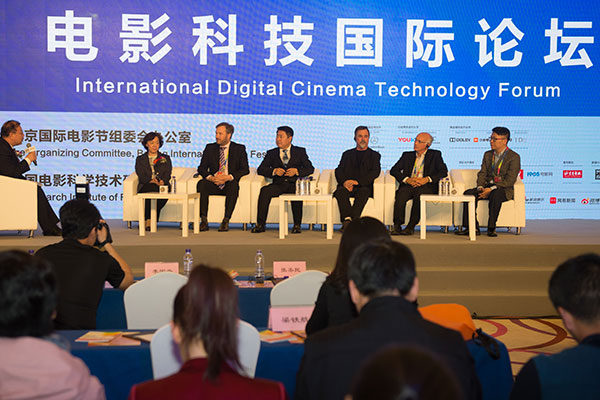
Seven domestic and foreign leaders in the film technology field were invited to deliver keynote speeches and explore the impact of technologies on the future of the film industry at the International Digital Cinema Technology Forum this year. They are Zhang Wei, Director of the Film Technology Quality Inspection Office, SAPPRFT; Julian Philip Pinn, Chair of the ISO Standards Committee for Cinematography; Michael Armen Karagosian, founder and President of American film technology consultancy MKPE; David Griffith Stump, Technical Director of the American Society of Cinematographers; Glenn Kiser, Senior Director of Dolby Institute; Yu Dong, President of Bona Film Group; and Liang Tiehang, Deputy Director of the Industrial Research Institute of TCL Group, CEO of GoLive TV Tech Co., Ltd. and Vice President of the International Applications and Service Business Division, TCL Group.
Wang Ning: Welcome domestic and overseas film technology enterprises to Beijing
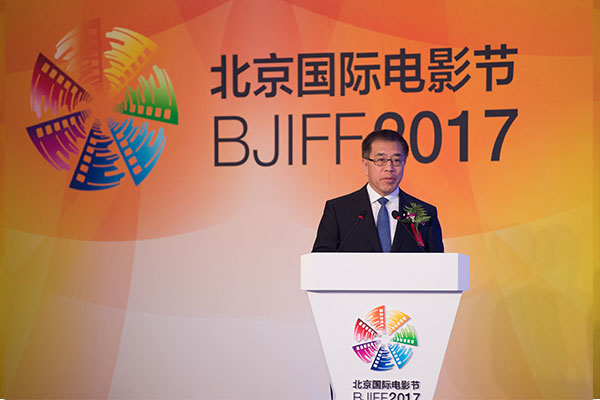
Vice Mayor of the People's Government of Beijing Municipality and Executive Vice Chairman of the Organizing Committee of the Beijing International Film Festival
The International Digital Cinema Technology Forum is a newly-established theme forum during BJIFF 2017. Under the theme of innovation-driven film upgrading, based on the leading edge of film technology development, the forum focuses on the application of high technologies, seizes the trends of film technologies, and brings together film technology talents to exchange ideas, share experience and seek common development. This is of great significance to enhancing technology exchange, promoting international cooperation, and pushing forward film technology innovation and film industry upgrading.
As a national cultural center, technology & innovation center and international exchange center, Beijing has profound cultural deposits and strong power for innovative development. With a great concentration of film production, distribution and screening institutions, as well as outstanding film creators and film technologists, Beijing presents more than half of domestic films every year, and has the largest film market in the country. The International Digital Cinema Technology Forum will boost the connotation of BJIFF, promote the prosperity of Beijing's cultural industry, promote international filmmaker exchange, and constantly push forward Beijing's urban construction.
Today Beijing is embracing film technology talents from around the world with open mind, welcome domestic and overseas film technology enterprises to Beijing. We will try our best to offer you the greatest convenience and best services. I believe that the forum will boost film technology innovation and high technology application, and promote the better and faster development of film industries in China and the world.
Zhang Pimin: Art and technology are the wings of films
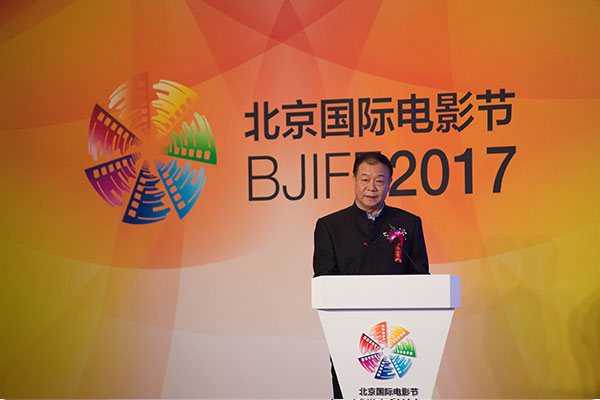
Vice President of the China Alliance of Radio, Film and Television
The International Digital Cinema Technology Forum is a professional forum of BJIFF starting this year as the country is strongly advocating technology innovation and China's film industry has made remarkable achievements. Films are a perfect combination of art and technology. Art and technology are both indispensible to films like wings to birds. Exquisite artistic quality and fine production add splendor to films. The extensive application of high technologies can boost viewing experience.
International Digital Cinema Technology Forum at BJIFF is a reflection of the concept of innovation and development, and strengthens the awareness of serving the film industry. The forum brings together leading experts, scholars and insiders in the field of film science and technology from home and abroad to conduct a research and exchange in the theme of The Innovation of Science & Technology Driven Cinema Quality Upgrade—this is of great significance to promote the exchange of Chinese and foreign film technology, improve the level of China’s film technology, and accelerate the construction of China being a film powerhouse. It is my hope that experts, scholars and insiders present can capitalize on this BJIFF forum as a platform to offer advice and suggestions to the sustainable and sound development of Chinese film industry, and to contribute their wisdom and strength to the prosperity and progress of the world’s film industry, through brainstorming, in-depth exchanges and serious discussion based on the theme.
Zhang Wei: Demand of mankind for cultural art works is the engine of film technology change
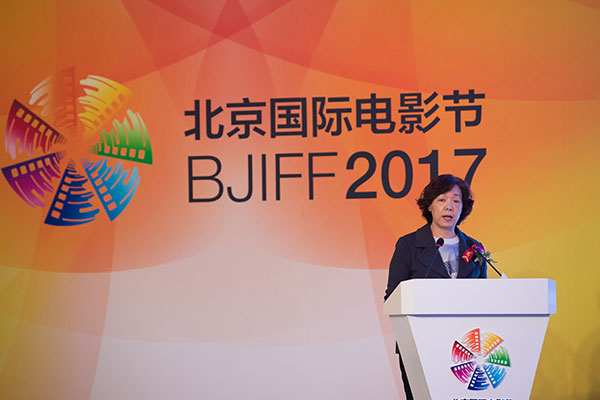
Director of the China Research Institute of Film Science & Technology and the China Test Institute of Film, the State Administration of Press, Publication, Radio, Film and Television of the People's Republic of China
During the production of digital films in China today, a complete process chain has been formed, and a relatively well-developed technical management process has been established in quality control, technological process management, content security and digital protection. During the entire development process, core elements behind the development of film technology are quality and security, and the possession of superior audio-visual quality and perfect content security assurance is the basic condition for survival of film and where the power of life rests in. And it is inevitable trends for the development of film technology and industry to consistently pursue excellent audio-visual quality and viewing experience, thus enabling viewers to obtain remarkable senses of immersion, immediacy and reality in cinemas different from on other media.
The following five major technologies have a huge impact on the frontier development of the film industry, namely, emerging audio-visual technology, cloud computing and big data, artificial intelligence (AI) and machine learning, virtual reality (VR) and augmented reality (AR), and blockchain. These technologies further deepen the understanding of film nature: Chinese film should follow a road of high-tech self-innovation and development by making great efforts to develop computer vision, computer graphics, human-computer interaction and other technologies through constant innovation and richer production means; the integrated use of 4K, 3D, high frame rate, HDR, wide color gamut, laser and other audio-visual means will comprehensively enhance the technical content of domestic films as well as the audio-visual quality and viewing experience in theaters; and it is a must to accelerate the creation of intelligent production process and business model for modern films based on big data analysis and machine learning, and promote the upgrade of film production process and industrial structure, in order to achieve the laws of scientific industry development, accurately grasp industrial trends and effectively avoid industrial risks.
Last but not the least, I hope that all of you can keep an eye on cross-over opportunities, that is, to be able to take full advantage of high-speed Internet, mobile Internet, broadband wireless condition, mass storage and other technologies, offer innovative film viewing modes, expand the space for the film market, develop value-added services, and expand film market gains. This is a blue ocean and is also an area full of opportunities. If we know both domains well, the opportunity will be bigger. Demand of human beings for rich and colorful cultural art works is generally the driving force of film technology innovation and change, during which personnel like us engaged in film technology must be sensitive, constantly master the trends of the development of the cutting-edge technologies through learning and understanding and make them work for us.
Yu Dong: Chinese film companies must dare to pull the same lead over the world-class studios in big screen

President of Bona Film Group
Over the past decade, the rapid growth in the number of cinema screens and the technological progress of the screening market in China has forced Chinese films to quickly catch up with foreign films with world-class film production process. You’re sure to still remember there was a 3D film called Avatar that made a track record in box office in China several years ago, when China only had 800 3D screens and 12 giant screens across the country. In such a screening condition, the film reeled in US$204 million in box office numbers, of which only RMB 200 million came from non-3D cinemas. At that time, Bona invested in a 3D cinema, the first one of its kind in Shijiazhuang, Hebei Province, where one of the screens offered continuous showings for 24 hours, with nearly 10 films on a daily basis.
Technological development brings wider space for film creation and more imaginations with its stereoscopic & in-depth impression and perfect special effects. China’s first 3D animal shot was made in the film The Taking of Tiger Mountain directed by Tsui Hark. In preparing the film, Ang Lee's Life of Pi came to the public and caused a great impact on the circle of Chinese films. Therefore, Tsui Hark stopped the film shooting. In my opinion, since the most important part of the film is beating the tiger and climbing Tiger Mountain, to achieve best special effects which last 20 minutes, he postponed the shooting till the next year. The film released during the Christmas in 2014 earned warm applause from the audience for its special effects, which were processed by an Asian team on all the reactions of a Manchurian tiger in the zoo, providing precious experience for the future production of 3D special effects in China.
Billy Lynn's Long Halftime Walk invested and distributed by Bona Film Group in 2016 is the world’s first 4K 3D film at 120 FPS. At the investment, the film aroused a wide concern for its super advanced technologies and incapability of display in any cinema in China and even the world. However, when the 120 FPS image was shown to the public, it was amazing. It provided a possibility to the film industry all over the world--a fully immersive vision.
For now, there are only five screens in the world that satisfy 120FPS, including several invested by Bona. The cinema in Beijing with only 243 seats recorded full capacity for each display, contributing to a box office of over RMB10 million per screen and RMB640,000 per day. In addition, the cinema in Shanghai also made historic records with nearly 1,000 seats, contributing to a box office of over RMB20 million per screen. The two halls drove an overall upgrading of the servers in 2K, 3D and 60 FPS in China and a jump of at least three levels for the 3D effect in China.
China is an interesting market. In 2016, a new product called “web movie” was born in China. How about its output in 2016? More than 1,600 films were displayed online, doubling the output of films. According to iQIYI, at least 3,000 films were produced by now in 2017. For such a mass production of online contents, once the contents fail to meet the viewing experience, the cinemas may suffer from dull business. We have experienced such kind of crisis. In the late 1980s and early 1990s, lots of theaters and cinemas were shut down, especially in the counties and prefectures.
Therefore, it is important to stress the significance of technological advancement. The competitions for the next decade will focus on the market of cinema screens. In brief, films need fours factors: 1) High investment which is the commercial feature; 2) unique artistic charm; 3) technological development; and 4) humanistic feelings. The four factors constitute a good film, which is definitely not an instant product driven by capital but integrates the high emotions of artists, modern technologies and professional skills. China exceeds North America in the number of screens, becoming the largest market of film screening. China now leads the world in the level of film screening of cinemas for the world-leading new technologies, which requires the production standards of Chinese films to satisfy the demand of technical devices. Otherwise, it is like we give away the display market with our numerous investment to Hollywood films, and our films can only survive on small screens like IPAD under the era of Internet.
Apart from the sense of social responsibility, Chinese filmmakers, for now, need persistence to the film nature and original intention. Therefore, facing the fierce competitions with Hollywood films, the Chinese producers should be responsible and brave to compete with the world-class film production companies on the big screen.
Glenn Kiser: Dolby brings experience into reality
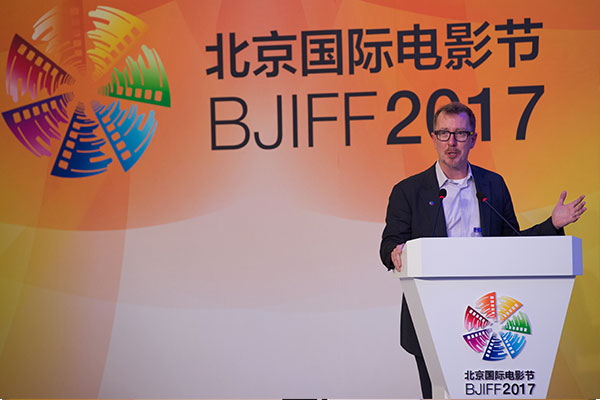
Senior Director of Dolby Institute, Dolby Laboratories, once in charge of Skywalker Sound under Lucasfilm Ltd.
The vision and objective of Dolby is to promote the visual presentation. We hope the audience can use all the senses to change their viewing experience and fully enjoy the contents that the producers, photographers and audio engineers want to deliver.
Dolby Vision is a new technology that can better promote home theatre and cinemas in the market. It is a pity that currently, part of visual information is often sacrificed as content is presented in cinema. In particular, at the stage of distribution, the great loss of the abundance of color and contrast leads to audiences’ experience in home theatre and cinemas far below real shooting effect. However, with Dolby Vision technology, we can restore these colors that fail to be presented in cinema. It aims to improve the quality of pixels, including higher resolution and frame rate as well as higher dynamic range.
In addition, sound effect is also crucial. From single channel at the beginning to the stereo and later 5.1 and 7.1 versions, sound effect of film has not yet pushed the limit of channel. Nevertheless, Dolby makes things happen in a new way. Instead of channel, the technology relies on object to present the sound in 3D environment as a whole. The so-called Dolby Atmos places speaker array on the ceiling and different places to localize sound source to immerse viewers into the surroundings.
Our imaging, cinema playback and sound playback effects, when combined together, will provide viewers with a high-quality cinema experience. For instance, you will see an audio-visual channel, with the most typical configuration being a 60-foot silver screen, where you can identify the objects in different scenes and learn about them in immersive environment. This is not a conceptual product, and currently 16 screening rooms have been set up in 14 cities across China. Dolby technology has been used in producing 16 Chinese films, including Operation Mekong and The Taking of Tiger Mountain and Dolby Atmos will also be applied in Chinese film production.
Liang Tiehang: Simultaneous release expands the overall size of box office

Deputy Director of the Industrial Research Institute of TCL Group, CEO of GoLive TV Tech Co., Ltd. and Vice President of the International Applications and Service Business Division, TCL Group
The core of simultaneous release with cinema is to enable users of Smart TV platforms to see films released simultaneously with cinemas. But why did it not come true during the development of Internet over the past 30 years? It must have something to do with technology, and we’ve done three most innovative things for simultaneous release.
First, to transform TV into a movie player. Movie player has its very important attributes in guaranteeing the safety of the media and the intact of the content. It requires a complete technical system, or the so-called DCP packaging PDM structure. We’ve introduced this standard into the ordinary Smart TV so that the latter can be used as both TV and a movie player.Second, to synchronize the content from the window period of cinemas. Technically, we can simultaneously play the film 8 days after it is screened in cinema. Two questions: one is how to supervise the box office? As it is not us, but China Research Institute of Film Science & Technology that is in charge of the management and generation of the key, each key is a cinema for the viewer. So the second question is, will it impact to some extent the current commercial cinema? We’ve found in the research that the film viewers in China are very young. Data shows that 95% of Chinese cinema users are 15 to 35 years old, and they go to the cinema to see films, or more likely, just out of socializing demand. This age group is very complementary with TV users, i.e. those below 15 or above 45. Moreover, although the number of screens in China’s commercial cinemas has exceeded the United States and became the world’s first, they are mainly found in first and second-tier cities, and few in the third and fourth-tier cities or the rural areas. Therefore, simultaneous release with the cinema solves the urban and rural differences in this aspect.
Second, to synchronize the content from the window period of cinemas. Technically, we can simultaneously play the film 8 days after it is screened in cinema. Two questions: one is how to supervise the box office? As it is not us, but China Research Institute of Film Science & Technology that is in charge of the management and generation of the key, each key is a cinema for the viewer. So the second question is, will it impact to some extent the current commercial cinema? We’ve found in the research that the film viewers in China are very young. Data shows that 95% of Chinese cinema users are 15 to 35 years old, and they go to the cinema to see films, or more likely, just out of socializing demand. This age group is very complementary with TV users, i.e. those below 15 or above 45. Moreover, although the number of screens in China’s commercial cinemas has exceeded the United States and became the world’s first, they are mainly found in first and second-tier cities, and few in the third and fourth-tier cities or the rural areas. Therefore, simultaneous release with the cinema solves the urban and rural differences in this aspect.
Third, to watch advertising to redeem the movie tickets. People always buy ticket to see a film, however, after the introduction of Internet, there is a new way --with the advertising channel, people can see a movie without buying a ticket-- the advertisers do that for you. Therefore, simultaneous release with cinema does not reduce the box office; rather, it expands the size of it.
Thus, simultaneous release has three missions: First, to allow all Chinese to be able to see films, making up for rural-urban difference in commercial cinema distribution. Second, to let each film have the opportunity to shine. China's annual output of new films is 500, but only 30% of them can be screened in cinemas, almost the same as that in the US. How to make films with small and medium investment achieve high box office receipts? Smart TV simultaneous release can solve the problem, as there's no need to focus on one fixed content shown within a space, it can make artistic films, long tail films, and cult films achieve high box office receipts, and the sore point of filmmakers of China and the world can be relieved. Third, to make Chinese films enter the global market. Except Hollywood, there's no other country's film culture can cover the global film market, which is quite demanding. How to export Chinese culture? We have found an effective way, that is, through exporting smart TV sets. Data show that China exported over 15,000,000 smart TV sets last year. By means of this platform, we can get rid of middle links and deliver contents to each family directly.
Released on:April 20,2017

